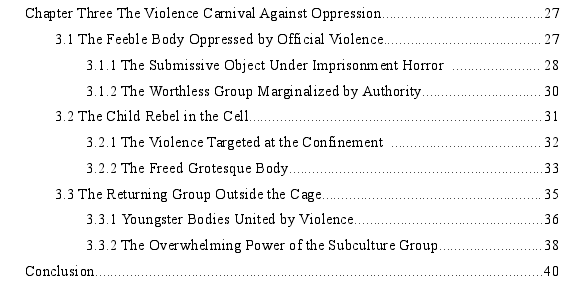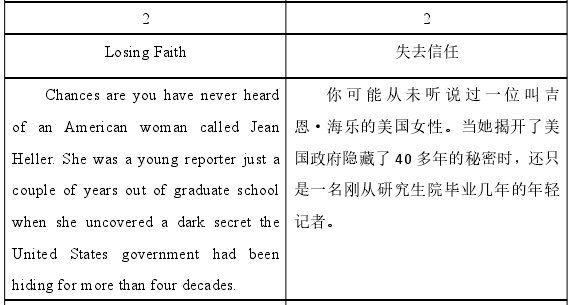英语论文哪里有?通过对小说中不同学科的详细阐释,可以看出狂欢节在这样一个有纪律的社会中是对权力的积极颠覆。嘉年华会的策略确实能激发被动身体对自由状态的追求。在开放广场上的狂欢节上,亚文化群体将有更多的选择来体验欢乐,尽管他们是身体受到压抑的受损人群。
Chapter One The Sexual Carnival Free From Bondage
1.1 The Tamed Body Shaped by Social Tradition
Exposed to the influential social traditions and customs, the individual’s body isnever a mere free-willed body of a person, but a disciplined combination of thecivilized community and the purified family. Proposed by Michel Foucault as a keyconcept in Discipline and Punish, discipline aims to cultivate a useful but submissivebody within the set framework. The more useful the body is, the more obedient it hasto be. To a certain degree, the free body since its birth has already been invisiblytamed by the family — the smallest unit under the strict censorship of the mighty society. A huge number of obedient citizens like David and Harriet in The Fifth Childwere cultivated by docile families, especially by the middle-class families whichinherited the majority of Victorian heritage. “For a long time, the story goes, wesupported a Victorian regime, and we continue to be dominated by it even today”(Foucault, The History of Sexuality 3). Indeed, the Victoria Era was literally gonewhile the ancient Victorian family value had already permeated itself to every cornerof British modern life in the post-war period. The wife was still supposed to be aperfect mother whose achievements were mainly evaluated by housework handlingand children rearing, and the husband as the main bread-winner was the real master ofthe house. To some extent, the labour distribution in the marriage set a marital modelin the form of tradition, limiting long-term marriage life to a rational domain. Thefundamental bodily life between two sexes was thus withdrawn to a hidden place withsilence principle, and the sexual happiness satisfying the flesh was totally muted infront of others. “Sexuality was carefully confined; it moved into the home” (Foucault,The History of Sexuality 3). Every time when it comes to the sexual desire, there willalways be a strong forbidden voice from the social tradition preventing the free bodiesfrom sexual carnival.

Chapter Two The Consumption Carnival Against Restraint
2.1 The Restrained Body Cultivated by Industrial Society
In the grip of fast industrial development, the body as a combination of aptitudeand profits is regarded as an object which can be utilized as much as possible.According to Foucault, body is dominated by disciplinary power which controls allthe movements for the sake of maximal effect by rules and surveillance. “The growthof a capitalist economy gave rise to the specific modality of disciplinary power,whose general formulas, techniques of submitting forces and bodies” (Discipline andPunish 221). The bodies in The Fifth Child were taught to capitalize the limited time and create more fortune for the sake of individuals, especially in the 1970s whenunemployment hovered over whole Britain. Also, the return to Victorian valuessuggested by the then Prime Minister Margret Thatcher directly strengthened thebelief that obedient bodies should be useful citizens with temperance. Apart fromdiligent work in the public sector, the frugal citizens were also disciplined to waiveirrational private spending and unnecessary expenses in the family domain.
Honestly speaking, the vibrant body is reduced to be a useful tool and passivemachine in the prison of disciplined power. The restrained bodies in the industrialsociety are more machinery-like workers than real bodies which meet their own needs.Too many disciplines attached to natural body make it rather hard to enjoy oneself insuch a money-oriented scheme. A real interpersonal relationship with each other isnowhere to be found between the cold objects due to the fact that difference behindthe position, property and class matters. Actually, the alienation between familymembers is not a rare phenomenon. Their bodies have already been distorted to bestiff machines without consumption or exchange. What the majority of people careabout are profits produced from the labour and the corresponding ranks of theneighboring families.
Chapter Three The Violence Carnival Against Oppression
3.1 The Feeble Body Oppressed by Official Violence
In order to cultivate loyal servants of officialdom, the concept of punishment has already permeated every corner of the society, especially targeting the potentialrebellious bodies among the multitude. Among all the punishments, imprisonment asa central technique of causing pain haunts the sensitive nerves of the feeble bodies.For the bodies who had already suffered from the torture, they would naturally relatethe bodies with terrible images in their minds when warned of punishment. To someextent, the individuals familiar with the possible consequences had no choice but tosurrender in front of corporal punishment, rationing of food, and solitary confinement.
The authority also has its back-up to tackle the situation if imprisonment horrordoesn’t perfectly work on these rebellious bodies. In comparison with meek bodies,the aggressive ones are classified to be abnormal and distorted from the perspectiveof mainstream society. Namely, they are not the ideal productions of the civilizedsociety but primitive monsters without any economic use. What is worse, they areportrayed as rampant delinquents threatening the family as well as the society by thenewspapers, which makes the system of violent punishment and close supervisionmore acceptable. A brand-new defence framework directed at the body rebellionbegan to take shape and the real isolation from the whole society formed. Themonstrous body was marginalized from the civilized society, and the real needs of therebel were totally ignored by the disciplinary unit. The desperate body wassurrounded by the idea of pain.
3.2 The Child Rebel in the Cell
Despite the haunting horror caused by punishment, the repressed young body inthe violence carnival successfully escaped from the official cell and grabbed thedominance over the dying law and authority. With roars and strength, the child rebelBen, namely the “monster” locked in the cell, overthrew the confinement through ajoyful violence ceremony. As regards the victims of the blows and abuses, “they areall subject to mockery and punishment as individual incarnations of the dying truthand authority of prevailing thought, law, and virtues” (Bakhtin, Rabelais and HisWorld 212). Clearly, the carnival in the form of constant blows and thrashings is nevera merely intense clash between individuals’ bodies, but a violence rite withregenerating power. “The blows have here a broadened, symbolic, ambivalent meaning; they at once kill and regenerate, put an end to the old life and start the new”(Bakhtin, Rabelais and His World 205).
During the process of violence carnival, the rebel’s grotesque body closelyassociated with fertility showed its remarkable power. The grotesque body is “a bodyin the act of becoming. It is never finished, never completed; it is continually built,created, and builds and creates another body”. Moreover, “the body swallows theworld and is itself swallowed by the world” (Bakhtin, Rabelais and His World 317).The exaggerated organs as the merry bodily elements are the doors to freedom. Thechild’s gaping mouth which devours everything as the central grotesque image erasedthe limitation of rigid bodies as well as life and death. Through the merry act of eatingand chewing, the young body enriches itself when swallowing the serious world ofoppression. What the freed grotesque body actually conquers is the intimidatingprison and the ingrained horror.

Conclusion
Hailed as a sensitive observer and passionate novelist, Doris Lessing is adept atunveiling the real world in a unique way and conveying significant hints between thelines. In her prolific literary career that lasted for 60 years, the rebellious author hasalways experimented with new writing styles when keeping a sharp eye on the livingdilemma of modern people in the contemporary world. The Fifth Child known as ahorror story exactly stemmed from her intention to write an ancient fable. While mostof the critics commented on the horrible disaster caused by the deformed body,Lessing tended to stress the inevitability of power’s replacement by the deformedbody and positive elements within the novel. “But there were very positive things toit... The damaged children seemed to have quite a lot of fun...They used to go off tothese rock festivals and things like that. They did have a good time.”
As one of Lessing’s masterpieces back to realism in 1988, The Fifth Child is atext full of traces of carnival. In the fictional world scrupulously created by Lessing,all the characters including the obedient individual, the frugal group and themarginalized Other merrily engaged in various carnivals on the open square andrevolted against the disciplines imposed on them. During the process, the submissivebody which used to be the target of discipline turned out to be the ideal tool ofcarnival and actively participated in the ongoing revolts for freedom. The fragility ofthe official discipline is ruthlessly mocked by the merry elements in the carnival. Tosome extent, the subverting carnival with overwhelming power directly contributed tothe final victory over the strict restrictions on the body, and provided a feasible outletfor the repressed body in the alienated world.
reference(omitted)

